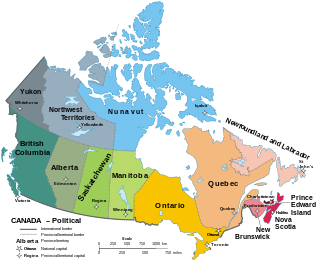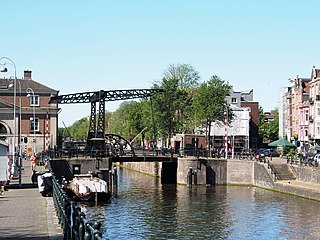
Proportional representation (PR) refers to any type of electoral system under which subgroups of an electorate are reflected proportionately in the elected body. The concept applies mainly to political divisions among voters. The essence of such systems is that all votes cast – or almost all votes cast – contribute to the result and are effectively used to help elect someone. Under other election systems, a bare plurality or a scant majority are all that are used to elect candidates. PR systems provide balanced representation to different factions, reflecting how votes are cast.

Canada has ten provinces and three territories that are sub-national administrative divisions under the jurisdiction of the Canadian Constitution. In the 1867 Canadian Confederation, three provinces of British North America—New Brunswick, Nova Scotia, and the Province of Canada —united to form a federation, becoming a fully independent country over the next century. Over its history, Canada's international borders have changed several times as it has added territories and provinces, making it the world's second-largest country by area.

Sonia Gandhi is an Indian politician. She is the longest-serving president of the Indian National Congress, a liberal political party, which has governed India for most of its post-independence history. She took over as the party leader in 1998, seven years after the assassination of Rajiv Gandhi, her husband and a former Prime Minister of India, and remained in office until 2017 after serving for twenty-two years. She returned to the post in 2019 and remained the President for another three years.
The year 1913 in architecture involved some significant events.

Astoria is a Jugendstil office building at Keizersgracht 174–176 in Amsterdam, built in 1904–1905 as the headquarters of the Eerste Hollandsche Levensverzekerings Bank insurance company. The building, at the intersection of the Keizersgracht and Leliegracht canals, served as the international headquarters of Greenpeace for 15 years. In 2001, it gained rijksmonument status.
Antje is a female name. It is a Low German and Dutch diminutive form of Anna. Once a very common name in the northern part of the Netherlands, its popularity has steadily declined since 1900.

Herman Hendrik Baanders, also known as Hermanus Hendrikus Baanders and H.H. Baanders, was a Dutch architect who was primarily active in Amsterdam.

The Blauwe Theehuis is a 1930s Modernist pavilion in the Vondelpark in Amsterdam, the capital city of the Netherlands. It is a ring-shaped building, somewhat reminiscent of a flying saucer. Originally a tea house, it is in use as a café and restaurant, surrounded by outside seating. The Blauwe Theehuis is also used for theatre performances, festivals, weddings, and other events. The building has rijksmonument status.

Heijplaat is a neighborhood of Rotterdam, Netherlands.
Baanders is a Dutch occupational surname. "Baander" was a name for a ropemaker. Notable people of the name include the following:

Nina Baanders-Kessler was a Dutch sculptor and medalist.

Jordanus (Daan) Roodenburgh was a Dutch urban-architect and former General director of AFC Ajax.

The Lauriergracht is one of the canals of Amsterdam, located in the Jordaan, west of the Grachtengordel.

The Leliegracht is a canal in Amsterdam, the Netherlands, between Herengracht and Prinsengracht. The canal lies within the western Grachtengordel in the Jordaan neighborhood of the Amsterdam-Centrum district.

The Schippersgracht is a canal and street in the Centrum district of Amsterdam that runs from the Rapenburgerplein to the Prins Hendrikkade.











